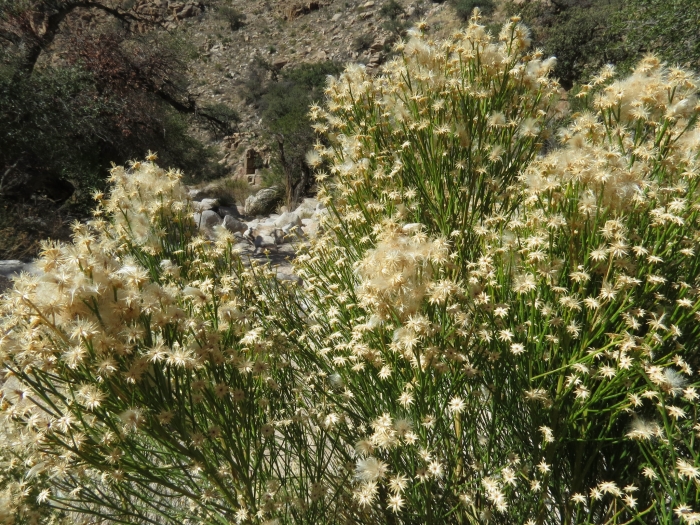Desertbroom
(Baccharis sarothroides)
Desertbroom (Baccharis sarothroides)
/
/

Katja Schulz
CC BY 2.0
Image By:
Katja Schulz
Recorded By:
Copyright:
CC BY 2.0
Copyright Notice:
Photo by: Katja Schulz | License Type: CC BY 2.0 | License URL: https://creativecommons.org/licenses/by/2.0 | Uploader: Josve05a | Publisher: Wikimedia Commons |











































































Estimated Native Range
Summary
Baccharis sarothroides, commonly known as Desertbroom, is an evergreen shrub native to arid regions, including desert washes, mesas, and slopes, as well as chaparral and scrub habitats in the Southwestern USA and Mexico. It is adapted to a harsh environment, often found in disturbed areas or along roadsides. This shrub typically grows to a height of 3-12 feet (1-4 meters) with a similar spread. Desertbroom has a distinctive appearance with its primarily leafless green stems that are sticky due to glandular secretions. The small, thick leaves are few and often absent, contributing to its spindly, twiggy look. It blooms profusely in the fall with tiny, inconspicuous green flowers on separate male and female plants.
Desertbroom is valued for its ability to thrive in challenging conditions, such as heavy clay or saline soils, and its rapid growth rate makes it a suitable choice for a temporary privacy hedge. It can be sheared and trained, providing quick coverage while slower-growing species mature. The plant is also drought-tolerant, requiring minimal water once established, making it ideal for xeriscaping and low-maintenance landscapes. In cultivation, it prefers full sun and can tolerate a range of soil drainage conditions, from fast to slow. While not commonly found in nurseries, it can be planted from purchased plants. Care should be taken to avoid overwatering, especially in heavy soils, to prevent root rot.CC BY-SA 4.0
Desertbroom is valued for its ability to thrive in challenging conditions, such as heavy clay or saline soils, and its rapid growth rate makes it a suitable choice for a temporary privacy hedge. It can be sheared and trained, providing quick coverage while slower-growing species mature. The plant is also drought-tolerant, requiring minimal water once established, making it ideal for xeriscaping and low-maintenance landscapes. In cultivation, it prefers full sun and can tolerate a range of soil drainage conditions, from fast to slow. While not commonly found in nurseries, it can be planted from purchased plants. Care should be taken to avoid overwatering, especially in heavy soils, to prevent root rot.CC BY-SA 4.0
Plant Description
- Plant Type: Shrub
- Height: 4-12 feet
- Width: 4-6 feet
- Growth Rate: Moderate
- Flower Color: White, Cream
- Flowering Season: Winter, Spring
- Leaf Retention: Evergreen
Growth Requirements
- Sun: Full Sun
- Water: Low
- Drainage: Fast, Medium, Slow
Common Uses
Bank Stabilization, Bee Garden, Bird Garden, Butterfly Garden, Drought Tolerant, Fragrant, Hedges, Low Maintenance, Rock Garden
Natural Habitat
Native to arid regions, including desert washes, mesas, and slopes, as well as chaparral and scrub habitats
Other Names
Common Names: Desert-Broom, Groundsel, Greasewood, Rosin-Brush, Broom Baccharis, Desert Broom, Escoba Amarga, Romerillo
Scientific Names: , Baccharis sarothroides, Baccharis sarothroides var. pluricephala,
GBIF Accepted Name: Baccharis sarothroides A.Gray